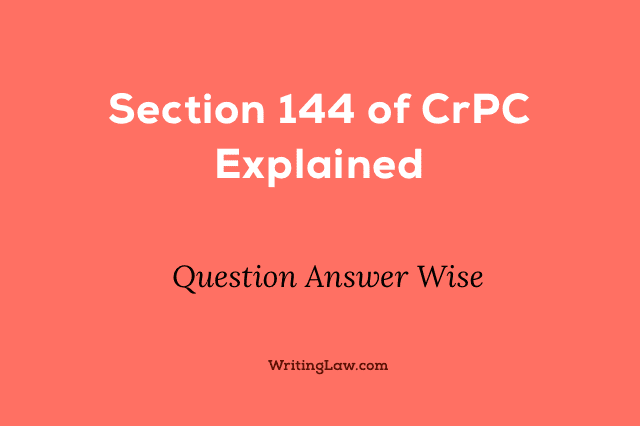
Section 144 of the Criminal Procedure Code is a technical tool to maintain security and peace in society. Section 144 of CrPC is imposed in urgent cases of apprehended danger of nuisance or disturbance in peace.
Section 144 of CrPC Explained
It is frequently in the news. Let us look at some leading questions and confusion related to section 144 of CrPC.
1. What is the power of Section 144 of CrPC?
Section 144 of the Criminal Procedure Code, 1973 provides power to the Executive Magistrate, District Magistrate, or Sub Divisional Magistrate of a state or territory to issue a written order prohibiting the assembly of five persons in an area or locality.
2. What is the reason behind imposing Section 144 CrPC?
CrPC’s Section 144 is imposed in urgent cases where there is sufficient ground for proceeding, and immediate action is required. Section 144 of CrPC usually prohibits public gathering.
3. A Famous Recent Use Case of Section 144 CrPC.
Section 144 has been used many times in the past as a means to prevent protests that could lead to riots. For Example, when Guru Ram Rahim was arrested, on the day of his sentence, section 144 was imposed in that area to prevent nuisance and apprehended danger to lives and property.
4. Does Section 144 CrPC restrict carrying weapons?
Section 144 also restricts a person from carrying any armed or deadly weapon with him. If any person carries it, the maximum punishment for such an act is three years.
5. What are the restrictions imposed by Section 144 CrPC?
According to the order, there shall be no public movement, and all educational institutions, whether private or government, shall remain closed. There will be a complete restriction on organising any kind of public meetings, rallies, shows till the order remains in operation.
6. Is the scope of Section 144 CrPC narrow or broader?
Section 144 CrPC also prohibits such activities or actions which are generally allowed on normal, regular days. To maintain peace and tranquility in an area, section 144 of the Criminal Procedure Code is imposed.
7. Is Section 144 for an individual or group?
An order under this section may be for a particular individual or to the public generally.
8. Is an order necessary to implement Section 144?
An order under this section may be passed even ex-parte if there is an emergent situation or if circumstances do not allow the serving of due time to the person against whom the order has been made.
9. What is the time limit for which Section 144 CrPC can be imposed?
Clause (4) of Section 144 CrPC says that ‘No order under this section shall remain in force for more than two months.‘ But if the state government considers it necessary, then it can extend the validity for two months, but not more than six months. The state government can withdraw it at any point in time if the situation becomes normal.
10. Does Section 144 CrPC mean Curfew only?
Generally, it is considered or assumed that section 144 of CrPC is nothing but curfew. But in reality, it’s not so. The scope of section 144 is much broader and wider. Curfew is only one of its segments.
- Article 334A of the Constitution of India - 14th April 2024
- Article 332A of the Constitution of India - 14th April 2024
- Article 330A of the Constitution of India - 14th April 2024








It’s always good to see these kinds mouthwatering articles…. !!!
Happy to read your words.
glad it helpful for public person’s
Glad you think so.
Thank u so much author for your hard work and dedication it’s really helpful.
Really happy with your kind words. Glad it was helpful to you. 😊
This information will help me a lot in my judiciary preparation . Thanku you.
Glad it is helpful. All the best for your preparation. 😊